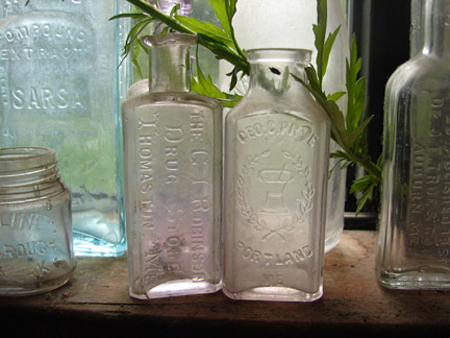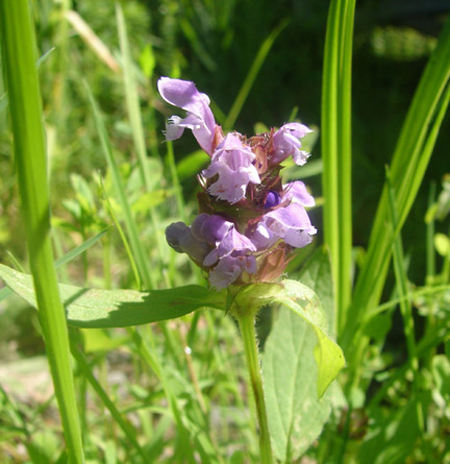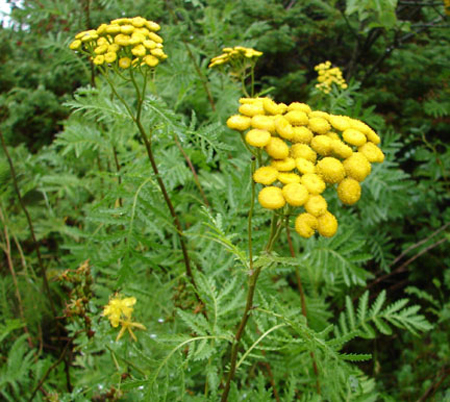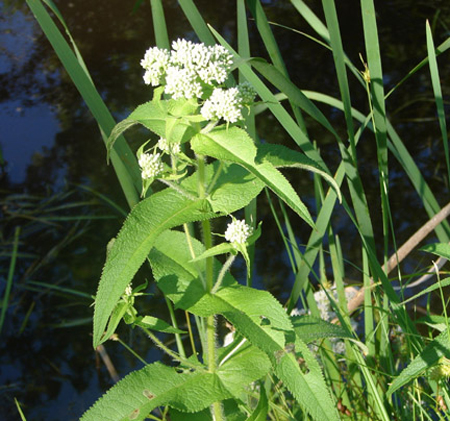Medicine Plants: A Legacy Of Maine’s Seafaring Past
by Tom Seymour

When the family dump was just beyond the barn most had a few of these patent medicine bottles in them. Many still do. Ancient remedies in 19th century packaging, the contents were used to treat many common ailments. Family dumps with lots of the same bottle may indicate the product’s alcohol content more than a particularly persisent medical problem.
Coastal Maine residents have at their disposal a virtual pharmacy of natural plant medicines. Before going further, always remember that while plant medicines may appear innocuous and harmless, it is still medicine. As such, serious drug interactions may occur when persons who take prescription medication self-medicate with medicinal plants. Always check with a doctor for possible side effects before taking any wild plant as medicine.
Concerning the various wild medicinal plants, September is prime time to harvest and dry them, since the volatile oils, those medicinally-active components, are at their peak of strength. Morning and evening are the best times for picking medicinal plants, as is any dark or cloudy day. Plants are not as effective if harvested during midday, when the hot sun diminishes their medicinal properties. Following are some classic favorites.
Heal-All
Old-time sailors learned of the healing powers of heal-all, Prunella vulgaris, during their travels to Europe and Asia. There, people used a tea from the flowering plant. Heal-all was introduced to the America possibly by accident, perhaps purposely. Nobody knows for sure.
Here in Maine, heal-all grows along shady edges of country lanes, in reverting fields and even on lawns. The plant has the curious, common name of “bumblebee weed,” due to the resemblance of the flower head to an old-fashioned bee skep, or hive body.

Old-time sailors learned of the healing powers of heal-all during their travels to
Europe and Asia. There, people used a tea from the flowering plant. Tom Seymour Photo
An astringent, a strong tea of heal-all fights throat, mouth and gum irritations. This is used as a mouthwash or gargle. Very strong infusions, taken in quantity, help to quell the effects of diarrhea. But that’s not all. Heal-all possesses antibiotic properties. Additionally, it contains ursolic acid, an antitumor compound.
So while those globetrotting mariners from up and down the coast of Maine may not have been aware of all the scientific properties of this common “weed,” they without a doubt used it for any number of ailments. In a day when vitamin C deficiency caused gum and mouth problems, heal-all was a valuable and no doubt, effective medicine.
Heal-all grows to slightly over 12 inches. Its leaves grow opposite each other on the stem. The cone-shaped seed head holds hooded, purple flowers. These never completely cover the head, giving the thing an unfinished appearance.
For use in a tea, first pick and dry the entire plant, leaves, flowers and all. Dry (this goes for any plant) on a nylon, not metal, screen. Or loosely place in a basket and hang from a beam in an airy location. Use one teaspoon of dried plant to one cup of boiling water. This formula applies to all other medicinal plants as well.
For a more potent brew, one for gargling to ease pain of sore throats, simmer a large quantity of heal-all in a large saucepan. Simmer until water turns nearly black then cool, drain and decant into a jar.
Tansy
Another herb known and used by seafaring men of old is tansy, Tanacetum vulgare. This grows to a height of four feet and has feathery leaves and bright yellow, buttonlike flowers held in a flat cluster atop the mature plant. Tansy grows along country lanes, dirt roads and also, just above the high-tide line up and down the coast of Maine.
Tansy contains thujone, which is suspected of being harmful to the nervous system. But the old-timers from Maine and other New England states favored tansy for an entirely different reason. It has insecticidal properties. Once, the leaves were rubbed on meat to keep flies away. It is also a flea and moth repellent.

An herb known and used by seafaring men of old is tansy. The plant contains thujone, which is suspected of being harmful to the nervous system. But the old-timers from Maine and other New England states favored tansy for an entirely different reason. It has insecticidal properties. Tom Seymour Photo
Tansy, too, is an alien, naturalized in this country. Used as a strewing herb (spread on the floor so when walked upon, it would release its essential oils and deter insects), tansy was also used in many food recipes. The alcoholic drink, Chartreuse, is flavored with a thujone-free extract of tansy.
Dried seedheads of tansy make wonderful dried flower arrangements. They keep their yellow color throughout the winter.
Boneset
Boneset, Eupatorium perfoliatum, also goes by the rustic name of thoroughwort. “Wort” simply means plant, or herb, and “thorough” refers to the plants prowess as a laxative. In other words, large doses thoroughly clean out the digestive system.
In fact, country folks, up to the mid-20th century, performed an annual ritual using thoroughwort. This entailed first, going about and picking huge quantities of the plant and then simmering it in water, making a potent brew. Each family member was assigned a day to take regular, metered doses of thoroughwort. This would result in regular, repeated visits to the privy. It was thought, and probably rightfully so, that such “cleansing” of the system was beneficial to the general health.
Boneset has a striking and singular appearance. It grows to nearly four feet tall and the lance-shaped leaves appear to join together at the stem. This creates the illusion that the plant’s stem grows through, or perorates (the source of the second half of the scientific name) the leaf.

Country folks, up to the mid-20th century, performed an annual ritual using boneset. This entailed first, going about and picking huge quantities of the plant and then simmering it in water, making a potent brew. Each family member was assigned a day to take regular, metered doses. Tom Seymour Photo
In August and into September, boneset develops fuzzy, white flowers, borne in flat clusters. Once identified, this plant is never forgotten, since nothing else looks quite like it.
In addition to its laxative properties, boneset has a number of other uses, prominent among these being its aspirin-like effects on those suffering from colds and flu. It was extensively used in 19th- and early 20th–century patent medicines. It’s for sure that these accompanied Mainers to sea, as part of the ship’s doctors collection of drugs.
Even today, homeopathic medicine uses boneset. While strong infusions of the plant contain possibly-harmful alkaloids, the homeopathic remedy uses only minute, or trace amounts. So here we have a link to the past, a modern, safe remedy that harkens back to the days of patent medicines.
Sailors Tobacco
Mugwort, Artemesia vulgaris, native to Europe and Asia, has naturalized nicely throughout the eastern United States. It grows near the shore, especially in gravelly, or nutrient-depleted soil. Related to the wormwood of scripture, mugwort has a number of traditional uses.
First, mugwort was once used as a tobacco substitute. This was due, in part, to its usefulness, when smoked, in clearing asthmatic lungs. Also, its widespread availability, especially along the shore, made it readily available to sailors who had used the last of their tobacco and needed something to satisfy the physical urge to smoke.
A bitter plant, mugwort was once used to clarify and add a bitter taste to beer. Additionally, the English used mugwort as a tea substitute when black tea prices skyrocketed in the early 19th century. Besides all this, mugwort tea induces sweating and stimulates the appetite.
Mugwort has a silvery-gray appearance. It grows to four feet tall and its leaves are deeply cut. Tiny, greenish flowers cling to a tall spike atop the plant in late summer and early fall.
Although mugwort, along with many other plants, has been pretty much displaced by synthesized remedies, they continue to grow along our roads, in or fields and up and down the coast of Maine. As such, they offer an interesting and tangible link to the past, when our sailors and fishermen relied almost exclusively upon wild plants as medicine.
